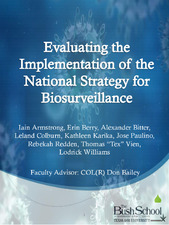Evaluating the Implementation of the National Strategy for Biosurveillance
| dc.contributor.advisor | ||
| dc.creator | Armstrong, Iain | |
| dc.creator | Berry, Erin | |
| dc.creator | Bitter, Alexander | |
| dc.creator | Colburn, Leland | |
| dc.creator | Karika, Kathleen | |
| dc.creator | Paulino, Jose | |
| dc.creator | Redden, Rebekah | |
| dc.creator | Vien, Thomas "Tex" | |
| dc.creator | Williams, Lodrick | |
| dc.date.accessioned | 2015-05-20T14:39:26Z | |
| dc.date.available | 2015-05-20T14:39:26Z | |
| dc.date.issued | 2015-05-20 | |
| dc.identifier.uri | https://hdl.handle.net/1969.1/154251 | |
| dc.description.abstract | Biological incidents, both man-made and naturally occurring, represent a significant threat to the national security of the United States. Identifying these crises begins with the detection and reporting of essential biological disease information, known as biosurveillance. As the first of its kind, the 2012 National Strategy for Biosurveillance targets the process essential information should take to reach decisionmakers. Although there are points of strength in the system, extensive research finds the current biosurveillance infrastructure does not adequately transmit information to decisionmakers. Therefore, this report recommends three improvements to the biosurveillance system: increase incorporation of information, improve interagency relationships, and strengthen governance in the biosurveillance community. | en |
| dc.language.iso | en_US | |
| dc.rights | Attribution-NonCommercial-NoDerivatives 4.0 International | en |
| dc.rights.uri | http://creativecommons.org/licenses/by-nc-nd/4.0/ | |
| dc.title | Evaluating the Implementation of the National Strategy for Biosurveillance | en |
| dc.type | Technical Report | en |
Files in this item
This item appears in the following Collection(s)
-
Graduate and Professional Student Degree Program Research (Non-ETD)
This collection is for TAMU graduate and professional student research completed as part of a degree program that does not fit the Thesis and Dissertation category administered by the Office of Graduate and Professional Studies (OGAPS). -
Master of International Affairs (MIA) Capstones



